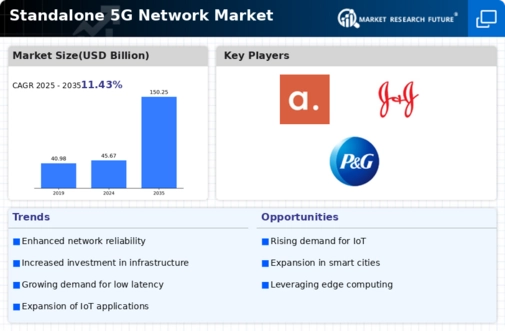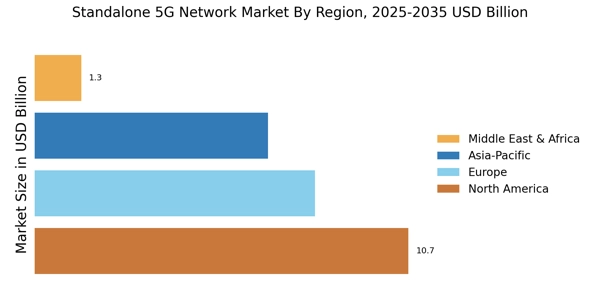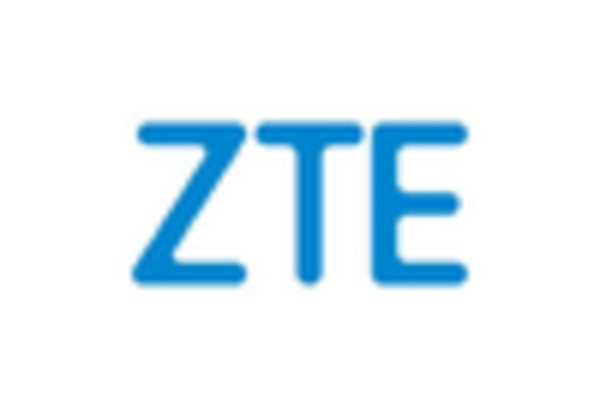Enhanced Network Performance
The Standalone 5G Network Market is poised for growth due to the enhanced network performance that 5G technology offers. With its ability to provide ultra-reliable low-latency communication, the Standalone 5G Network can support a myriad of applications, from autonomous vehicles to smart cities. This performance enhancement is expected to drive demand, as businesses and consumers alike seek faster and more reliable connectivity. According to recent estimates, the Standalone 5G Network could achieve speeds up to 10 Gbps, significantly surpassing its predecessors. This capability not only improves user experience but also enables new business models and services, thereby expanding the market landscape.
Support for Advanced Technologies
The Standalone 5G Network Market is significantly influenced by the support it provides for advanced technologies such as artificial intelligence, augmented reality, and virtual reality. These technologies require high bandwidth and low latency, which are hallmarks of 5G networks. As industries explore innovative applications, the Standalone 5G Network becomes a critical enabler. For instance, in sectors like healthcare, real-time data transmission can enhance telemedicine services. The market is projected to grow as enterprises adopt these technologies, with the Standalone 5G Network serving as the backbone for their implementation. This synergy between 5G and advanced technologies is likely to create new opportunities and drive market expansion.
Government Initiatives and Policies
The Standalone 5G Network Market is also being shaped by various government initiatives and policies aimed at promoting 5G deployment. Governments are recognizing the strategic importance of 5G technology in enhancing national competitiveness and economic growth. Initiatives such as funding for infrastructure development and regulatory support are facilitating the rollout of Standalone 5G Networks. For example, several countries have established 5G task forces to streamline the deployment process. This supportive environment is expected to accelerate market growth, as stakeholders are encouraged to invest in 5G infrastructure. The proactive stance of governments could lead to a more robust Standalone 5G Network Market, fostering innovation and technological advancement.
Rising Investment in Telecommunications
The Standalone 5G Network Market is witnessing a rise in investment in telecommunications infrastructure. As telecom operators and service providers recognize the potential of 5G technology, they are allocating substantial resources to develop and expand their networks. This investment is crucial for the successful deployment of Standalone 5G Networks, which require significant capital for infrastructure upgrades and maintenance. Market analysis indicates that global spending on 5G infrastructure is projected to exceed 1 trillion dollars by 2025. This influx of capital is likely to enhance network capabilities and coverage, thereby driving the growth of the Standalone 5G Network Market. The financial commitment from industry players underscores the anticipated demand for advanced connectivity solutions.
Increased Demand for High-Speed Connectivity
The Standalone 5G Network Market is experiencing a surge in demand for high-speed connectivity. As digital transformation accelerates across various sectors, the need for faster and more efficient networks becomes paramount. Businesses are increasingly reliant on data-intensive applications, which require robust network capabilities. The Standalone 5G Network, with its potential to deliver high-speed data transfer rates, is well-positioned to meet these demands. Market data suggests that the number of 5G subscriptions is expected to reach over 1 billion by 2025, indicating a strong appetite for advanced connectivity solutions. This trend is likely to propel the Standalone 5G Network Market forward, as organizations seek to leverage the benefits of enhanced speed and capacity.


















Leave a Comment